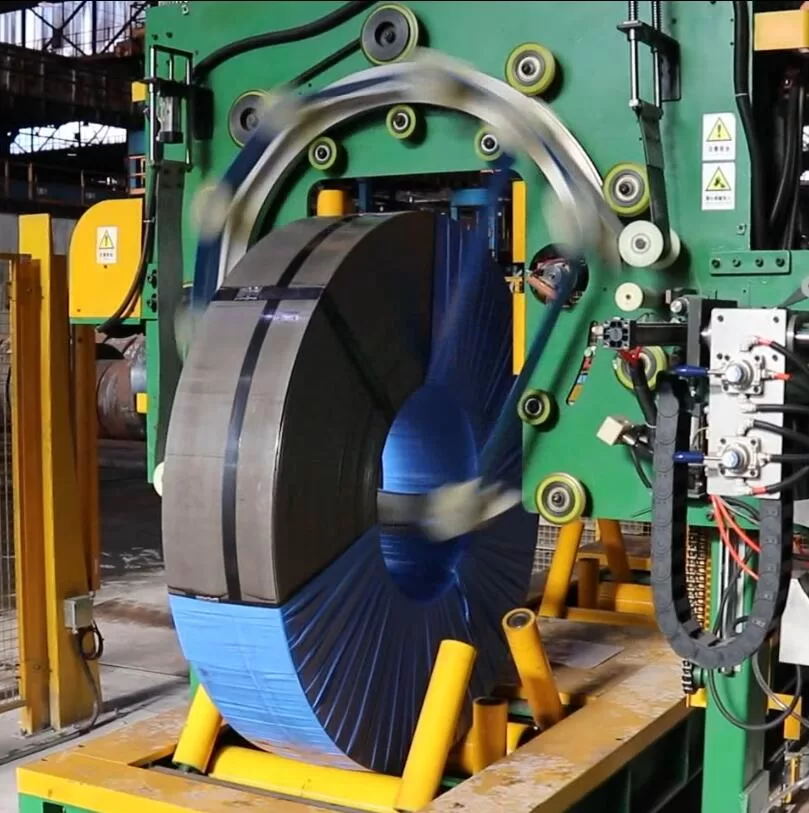Streamlining Operations: Integrating Coil Tilters and Coil Wrapping Machines
Handling and packaging large, heavy coils—whether steel, aluminum, or other materials—presents significant challenges in manufacturing and fabrication environments. Ensuring both operational efficiency and worker safety, while preserving product integrity, requires specialized equipment. Coil tilters and coil wrapping machines are crucial components in modern coil handling and packaging lines, designed to address these very challenges. This article explores the function, benefits, and integration of these essential machines.
Understanding the Coil Tilter (Upender/Inverter)
A coil tilter, often referred to as an upender or inverter, is engineered specifically to reorient heavy coils, typically rotating them 90 degrees. This changes the coil's axis from horizontal (eye-to-wall) to vertical (eye-to-sky) or vice versa.
- Primary Function: To safely manipulate coils for easier handling by forklifts or cranes, facilitate inspection processes, optimize storage space, or correctly position coils for feeding into processing lines (like slitters or presses).
- Common Types: Coil tilters are generally powered mechanically or hydraulically, each offering different advantages in terms of speed, capacity, and maintenance profile.
- Operational Impact: By automating the reorientation process, tilters significantly reduce the risks associated with manually attempting to reposition heavy, unstable loads.

steel coil packing machine for sale Demystifying the Coil Wrapping Machine
A coil wrapping machine automates the application of protective materials around the coil. This equipment is vital for preparing coils for shipment or storage.
- Primary Function: To securely wrap coils using materials like stretch film, VCI (Volatile Corrosion Inhibitor) paper, or other specialized films. This protects the coil surface from environmental factors such as moisture, dust, and physical damage, and prevents corrosion, particularly crucial for metal coils.
- Common Types:
- Orbital Stretch Wrappers: The wrapping material shuttle rotates around the coil as it passes through the machine's ring.
- Through-Eye (Axial) Wrappers: The wrapping material is fed through the eye of the coil and wrapped around its circumference.
- Operational Impact: Ensures consistent, tight, and effective packaging, far exceeding the uniformity and speed achievable through manual wrapping. It also optimizes the usage of wrapping materials.
The Integrated Workflow: Tilting and Wrapping in Sequence
Coil tilters and wrapping machines often function as part of an integrated handling and packaging line. A typical automated or semi-automated sequence might look like this:
- Loading: A coil is loaded onto the line's infeed conveyor or directly onto the tilter platform, often in an eye-to-wall orientation.
- Tilting: The coil tilter rotates the coil 90 degrees to an eye-to-sky orientation, which is often preferred for subsequent wrapping and handling.
- Transfer: The tilted coil moves via conveyor to the wrapping station.
- Wrapping: The coil wrapping machine applies the specified protective material(s) according to pre-set parameters (e.g., number of layers, overlap).
- Discharge: The fully wrapped coil is conveyed off the line, ready for labeling, storage, or shipment.
This integration minimizes manual intervention between steps, creating a seamless flow that enhances both speed and safety.
Key Advantages of Utilizing Coil Tilters and Wrapping Machines
Employing dedicated coil tilting and wrapping equipment offers substantial operational benefits:
- Enhanced Efficiency: Automating these processes dramatically reduces cycle times compared to manual methods, boosting overall plant throughput. Consistent operation allows for better production planning.
- Improved Workplace Safety: Mechanizing the lifting, tilting, and wrapping of multi-ton coils drastically cuts the risk of serious injuries associated with manual handling (e.g., strains, sprains, crush injuries). It helps facilities adhere to stringent material handling safety regulations.
- Superior Product Protection: Automated tilting prevents damage like dents or edge deformation often caused by improper manual handling. Precise machine wrapping ensures complete coverage, safeguarding valuable coils from corrosion, contamination, and transit damage, thus reducing scrap or rework costs.
- Optimized Material Consumption: Wrapping machines apply materials like stretch film with consistent tension and overlap, minimizing waste compared to often inconsistent manual application.
- Process Consistency: Automation delivers repeatable results every time, ensuring every coil is handled and packaged to the same standard, contributing to overall quality control.
- Customization for Specific Needs: These systems can be specified or customized to handle a wide range of coil dimensions (ID, OD, width) and weights. Wrapping parameters can be adjusted for different coil types or customer requirements. Tailored solutions are available for specific coil packaging needs.

steel packing machine3 Essential Operational Considerations
When implementing or upgrading coil handling equipment, several factors warrant careful consideration:
- Capacity: Ensure the machinery can safely handle the maximum weight and dimensions (inner diameter, outer diameter, width) of the coils processed.
- Power Source: Evaluate the suitability of hydraulic versus electric power based on plant infrastructure, duty cycle, and maintenance preferences.
- Control Systems: Determine the required level of automation, from simple push-button controls to fully integrated PLC systems communicating with plant-wide networks.
- Footprint and Layout: Assess available floor space and how the equipment will integrate with existing material flow patterns, including crane access and conveyor systems.
- Maintenance: Understand the routine maintenance requirements to ensure long-term reliability and safety.
Conclusion
In modern metal processing and fabrication, efficient and safe coil handling is not just an operational detail—it's fundamental to productivity and profitability. Coil tilters and coil wrapping machines provide engineered solutions that directly address the challenges of manipulating and protecting large coils. By integrating these technologies, manufacturers can streamline workflows, significantly enhance worker safety, ensure product quality through better protection, and achieve greater overall operational efficiency. Investing in the right coil handling and packaging equipment is a critical step towards optimizing production processes.
